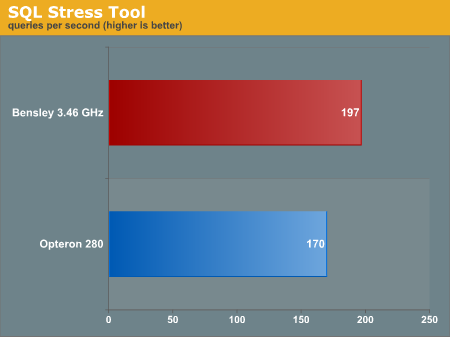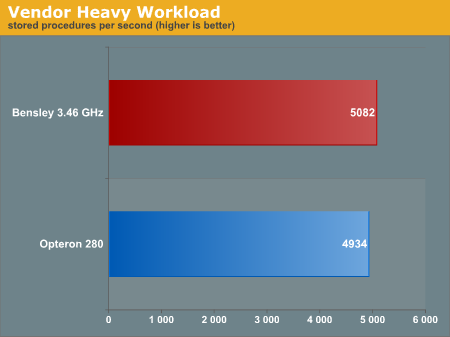Intel’s Dual-Core Xeon First Look
by Jason Clark & Ross Whitehead on December 16, 2005 12:05 AM EST- Posted in
- IT Computing
SQL Stress Tool Results(test description)
Intel’s pre-production Bensley system came out on top in this test, with a 14% lead over the Opteron 280 system. The 1066MHz front-side bus, no doubt, was required to achieve this result, along with the 2MB of L2 cache. Intel has always been competitive with AMD in this test, but was able to pick up an additional 4% this time around over their usual 10% lead.
This enterprise test has been of great interest to a lot of people, including Intel. Opteron has constantly dominated this test, but times have changed. Bensley essentially tied with the Opteron 280 in this test, as the difference was about 3% (which is standard deviation). The new Blackford chipset architecture, increased front-side bus and memory bandwidth all played a part in Bensley showing this kind of improvement. Where Opteron used to show, on average, a 15% gain over Intel, they are now neck and neck.
Intel’s pre-production Bensley system came out on top in this test, with a 14% lead over the Opteron 280 system. The 1066MHz front-side bus, no doubt, was required to achieve this result, along with the 2MB of L2 cache. Intel has always been competitive with AMD in this test, but was able to pick up an additional 4% this time around over their usual 10% lead.

This enterprise test has been of great interest to a lot of people, including Intel. Opteron has constantly dominated this test, but times have changed. Bensley essentially tied with the Opteron 280 in this test, as the difference was about 3% (which is standard deviation). The new Blackford chipset architecture, increased front-side bus and memory bandwidth all played a part in Bensley showing this kind of improvement. Where Opteron used to show, on average, a 15% gain over Intel, they are now neck and neck.











67 Comments
View All Comments
gjmck - Monday, December 19, 2005 - link
I'm curious that the numbers dont reflect the true difference between equivalently configured Intel vs. Opteron systems.The Dempsey processor TDP max is 130W and the Opteron is 95W. That difference is only 35W. The memory controller needed by Dempsey should only consume 60 - 80W. Using 80W that gives the maximum total difference between two eqivalently configured systems as 80 + 35 = 115W.
Yet in the max processor utilization tests the difference was 214 Watts. So where is the extra 99 Watts being used? FBD? If so then when Opteron uses similar memory technology the delta will not be as great.
Gregg McKnight
Furen - Thursday, December 22, 2005 - link
Intel's TDPs reflect "typical" power draw, while AMD's reflects the "worst-case scenario" power consumption, so they're not directly comparable. I very much doubt the memory controller uses even close to 80W, I'd say something like 20-30W for the whole northbridge is reasonable. FB does use more power, but that shouldn't be more than 5-10W per dimm. The rest is just the CPU being insanely power-inefficient.dannybin1742 - Friday, December 16, 2005 - link
to keep anthing at a constant temperature, the heat going into the system must equal the heat being taken away. so if one system uses 200W of power, first you have the cost of the 200W, then you have the cost to remove the 200W of heat given off by the use of the system. on top of this air, conditioners are 20-25% efficient at best (if i remember correctly), so the amount of power used to remove the heat generated would take 3-4X more energy to remove. so in essence you are looking at at LEAST 2X amount of money calculated in the article. (i took a year of thermodynamics at school here, when i was an undergrad) in reality, you are probably looking at 4-6X to run and remove the heat from the data center. they should have looked at the opteron 2.2ghz HE (low voltage) i'd be interested to see what power numbers those put up.also, was winxp 2003 server 64 bit? or were all the tests run in 32 bit? i just skimmed over the article. how about linux?
coldpower27 - Friday, December 16, 2005 - link
Opteron 270 HE is the highest of the lower wattage 2 Way Opterons and it runs at 2.0GHZ.
Viditor - Friday, December 16, 2005 - link
You mean 2 way dual core...
The 250 HE is single core at 2.4 GHz...
coldpower27 - Friday, December 16, 2005 - link
Yes, I assume 2 Dual Core vs 2 Dual Core.haris - Friday, December 16, 2005 - link
One question that kept nagging me was "How many "threads" were required to get the systems to each load level?" How much of a difference would it make to performance/watt if you have to take into account that processor 1 is also handling x% more/less threads then processor 2?Jason Clark - Friday, December 16, 2005 - link
That will teach me for just taking a $1,000 measurement devices reported figures :) It actually figures out the cost, which obviously was wrong. I've updated the numbers, they should be correct.Again, sorry :)
coldpower27 - Friday, December 16, 2005 - link
Thanks alot.:)Biffa - Friday, December 16, 2005 - link
With over a 1Ghz defecit (yes I know) in processor speed, and with only 1MB of cache per core rather than 2MB, I think we can safely say that Intel is still clutching at straws at this level of the game.Good PR on their part (always admired them for that) however its a crying shame that after all this time this is the best they can do.